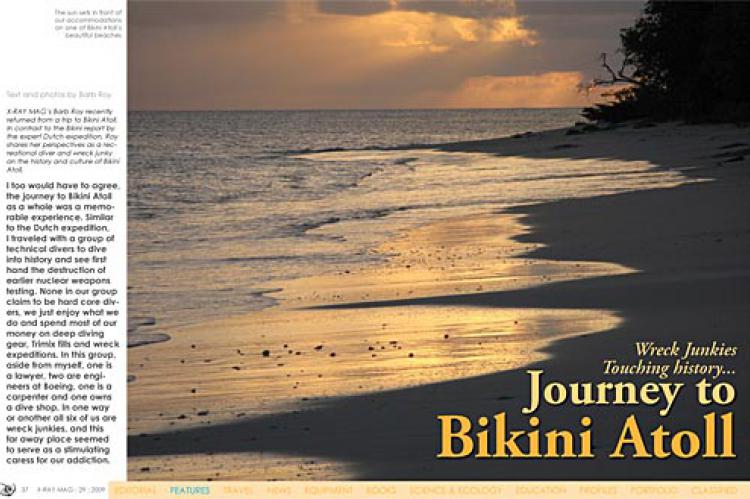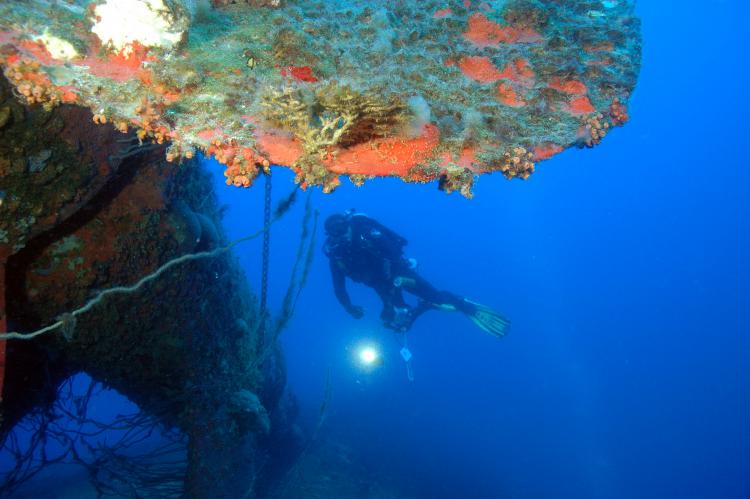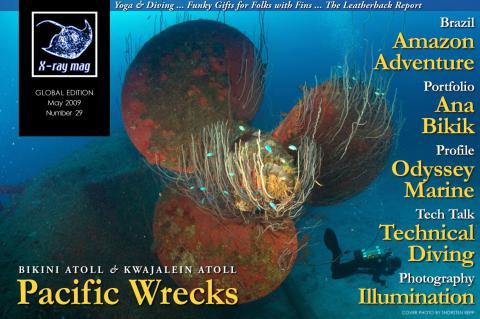Journey to Bikini Atoll
In contrast to the Bikini report by the expert Dutch expedition, X-RAY MAG’s Barb Roy shares her perspectives as a recreational diver and wreck junkie on the history and culture of Bikini Atoll.
Tags & Taxonomy
Although I am the only female in the group, and a travel journalist, I am accepted because I create these escapes and weave a recipe of pleasing surprises, challenging dives and always add a twist of exploration to the mix. The guys are also impressed that I am a grandmother of five and use a single tank to their doubles.
We departed from the northwestern part of the United States (Seattle), just below British Columbia, Canada, and flew to the island of Oahu in the Hawaiian Island chain for our first stopover. It was nice to leave our thick dry suits and heavy weight belts behind.
Unlike most tourists visiting Hawaii, sunbathing on warm sandy beaches and sipping Mai Ties was not on our agenda. No, touring the 887-foot (270-meter) long USS Missouri, an Iowa-class battleship and seeing the sleek steel-hulled USS Bowfin submarine at Pearl Harbor was all we could think about.
You might say it is an indescribable sensation when standing in the midst of the Mighty Mo’s nine 16-inch/50 caliber guns, realizing they are capable of launching 1,800-pound shells (as heavy as small automobiles) over a distance of 23 miles!
Mainly we wanted to get a sense of what the wrecks in Bikini once looked like before they were sent to the bottom of the ocean in 1946, and the USS Missouri did just that.
USS Missouri
The vessel is moored next to the USS Arizona Memorial, another battleship which was sunk during the Japanese attack on Pearl Harbor in December of 1941. This unforgettable time sparked the United States entry into World War II. Over 1,000 sailors and marines lost their lives within the Arizona when it went down. But it was the USS Missouri, now sitting next to the Arizona that hosted the end of WWII when Japan surrendered on 2 September 1945.
The ship’s tour included a chance to see where the crew was housed, their mess hall (food preparation and eating area), the medical facility and engineering departments. We were all in awe of the Combat Engagement Center where the Harpoon Missile System functions were and how they operated, especially the control operations for the 32 armored tomahawk missile launchers. The four 20mm Phalanx CIWS Gatling-style guns and the thick walled hatch into the ships’ Steering Room (reinforced to protect navigational operations) were equally impressive.
“The tour of the USS Missouri was a real high point for me,” said Rob Wilson, a Boeing aircraft maintenance technician, working in the military division, and diver for over 30 years.
“Seeing Pearl Harbor, especially the Arizona Memorial, and standing on the Missouri’s deck where WWII ended when Japan surrendered to General Douglas MacArthur really set the tone for the whole Bikini trip for me.”
The USS Missouri was the last battleship built by the United States as part of an elite group of fearsome ships constructed during naval warfare. Extensive upgrades were made on several occasions throughout the Missouri’s colorful deployments, the last being Desert Storm in 1991 where 28 tomahawks were launched against Iraqi forces. Today the “Mighty Mo” serves as a floating museum and memorial in Pearl Harbor open for daily guided and self-guided tours.
USS Bowfin
Another piece of history worthy of a visit while in Pearl Harbor is the USS Bowfin (SS-287), a Balao class submarine and a survivor of WWII. In 1942, the USS Bowfin was launched, and completed nine war patrols before being decommissioned and opened to the public in 1981 for tours as part of a museum display in the USS Bowfin Submarine Museum & Park. The sub is 312 feet (95 meters) in length and during its day boasted a speed of 20 knots when at the surface. Waterfront Memorial is also located in the park in honor of the 53 American submarines and over 3,500 submariners lost during WWII.
USS Apogon
Similar to the Bowfin is the 312-foot USS Apogon (SS-308), another Balao class diesel-electric submarine resting on the ocean floor as part of the Bikini Lagoon wreck dives. I found myself looking at the Bowfin imagining what it might be like standing next to the Apogon underwater.
Majuro
Before long, we were on our Continental Micronesia air flight to Majuro, the capitol of the Republic of the Marshall Islands in Micronesia. The atoll itself covers an area of 3.75 square miles (9.9 km) and is located in the Central Pacific, about 2,200 miles west of Oahu (five-hour flight) and about 2,600 miles east of Tokyo, Japan. U.S. currency is accepted and ...
Download the full article ⬇︎

Originally published
X-Ray Mag #29
Bikini Atoll - Expedition to the wrecks of Operation Crossroads :: Aftermath — at the nuclear playground :: Journey to Bikini Atoll :: Wrecks of Kwajalein Atoll in the Marshall Islands. Leatherback Turtle Report from Papua New Guinea :: Profiling Odyssey Marine :: Yoga & Dive :: Tech Talk: Why Technical Diving :: UW Photography: Illumination :: Portfolio Ana Bikic



